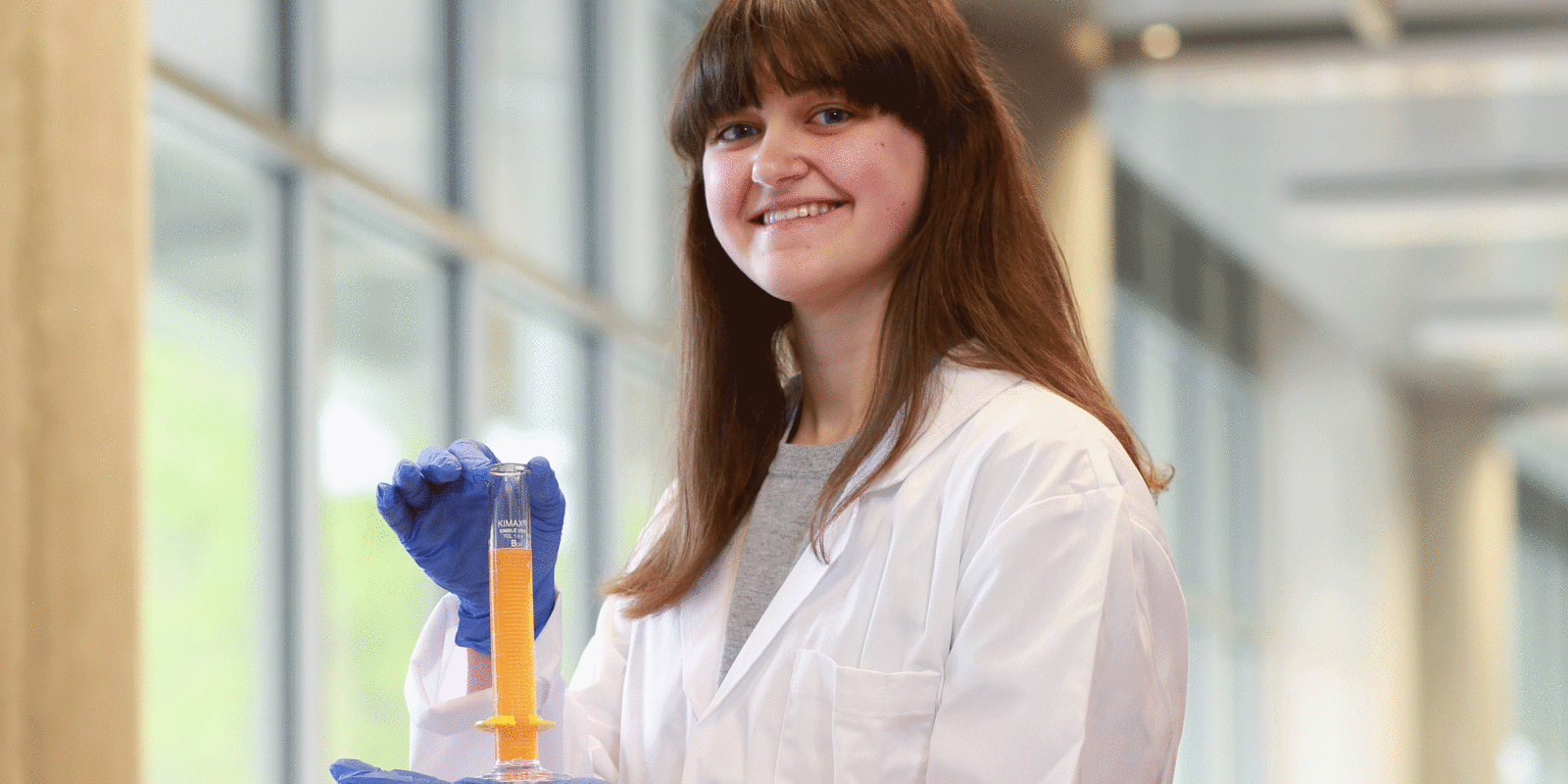
Engineering a Possible Diabetes Treatment
Lauren Getz is working to coat pancreatic islet cells in hopes of improving treatment of Type 1 diabetes.
Lauren Getz spends her days figuring out the perfect medium for microencapsulating islet cells destined for a human pancreas. The engineering major’s research work might have life-changing implications for people living with Type 1 diabetes.
Getz entered TCU with the long-term plan of becoming a physician. Her father, a dentist, inspired her interest in medicine, but research altered her path. Now, the junior is deliberating between biomedical engineering and a MD-PhD program.
In her freshman year, she added an introductory engineering course to the load of pre-med biology and chemistry classes. She loved the subject even though she knew very little about the fundamentals of engineering. “I like the challenges and thinking outside the textbook,” she said. “The real-world applications and problem-solving.”
After mentioning her career aspirations to a professor, Getz was referred to Tristan Tayag, professor of engineering, and the department’s expert in biomedical research. Tayag was working with Jeff Coffer, professor of chemistry, on a biomedical project to design a viable coating for transplanted pancreas cells in diabetics.
“There have been tests where they have tried transplanting human islets into a diabetic patient, and those have worked,” Getz said.
“We need a solution, and I’m getting into that way of thinking, how can we solve it?”
Getz
A pancreas functioning with transplanted islet cells is known as a bioartifical organ, and the results have been promising. While receiving transplanted islet cells restores functionality and negates a diabetic person’s need for constant insulin injections, it then necessitates a lifetime course of anti-rejection drugs.
“What we are trying to do is make it so that a patient wouldn’t have to undergo immunosuppressive therapy,” Getz said.
If the project is successful, it could help create an innovative, less expensive solution for Type 1 diabetes. Removing the need for costly anti-rejection drugs would save several billion dollars each year.
The American Diabetes Association estimates that one in three babies born this year will develop the disease. The Centers for Disease Control and Prevention published a 2007 study showing how $3 of every $4 spent on health care goes toward long-term treatment of a chronic condition, such as diabetes.
In addition, the method for coating islet cells could be applied to the treatment of cancer, heart disease and liver failure.
“There have been tests where they have tried transplanting human islets into a diabetic patient, and those have worked”
Getz
Students who worked on the encapsulation project in prior years designed the spinning bioreactor used to mix the islets with the coating material. The bioreactor instrument in Tayag’s lab is a disc that rotates like a wheel for several days. It is attached to a camera and a computer to record and analyze the composition of the liquid as it slowly reacts.
Getz is fine-tuning the collagen type I medium that will coat the islet cells. Collagen, which is the natural environment for the cells, allows them to be permeable enough to function but also hides them from the immune system.
When Getz picked up the project, the “do stuff” phase had begun. She applied for and received a Science and Engineering Research Center grant from TCU. The funding allowed her to devote most of the summer after her freshman year to learning the ins and outs of an engineering lab and getting up to speed on the work already accomplished.
Tayag helped Getz learn the research basics but, “he’s really good about being involved but also letting me figure out stuff myself,” she said.
In Tayag’s lab, Getz started experimenting with collagen solutions of varying viscosities. For trial runs, she substituted the islet cells with polystyrene beads, which are in the similar size range of 180 microns. The beads, however, are hydrophobic, very different from the fluid-loving islet cells with which she will eventually experiment. To compensate for the discrepancy, Getz worked with Coffer, using a plasma etcher, “making their surface rougher,” she said. The beads are as small as grains of sand.
In spring 2014, Getz started working with Dan Dimitrijevich, research associate professor at the University of North Texas Health Science Center in Fort Worth. His lab uses high-powered versions of the bioreactor Getz has been using at TCU. In his lab, she conducts trials with murine islet cells (from a mouse) because it is a sterile medical environment.
The research experiment is still in its early stages. After testing the bioreactor microencapsulation technique on living islet cells, the process will need to be repeated numerous times before even considering Food and Drug Administration approval for use in people with Type 1 diabetes.
Should that day come, Getz will have had plenty of time to acquire whichever graduate degree she decides to pursue. Regardless, her undergraduate research work at TCU will have long-lasting effects on her academic trajectory.
“It’s interesting working on something that is so prevalent and figuring out how to solve certain problems,” she said. “We need a solution, and I’m getting into that way of thinking, how can we solve it?”

Your comments are welcome
Comments
Related reading:
Features, Research + Discovery
The Case of the Disappearing Groundwater
Sharra Blair-Kucera left a 20-year career in manufacturing to study water conservation and resource management. She found that Texas is running out of groundwater.
Features, Research + Discovery
Spiders as Mercury Contaminators
Are spiders a missing link as toxic mercury moves from water onto land?